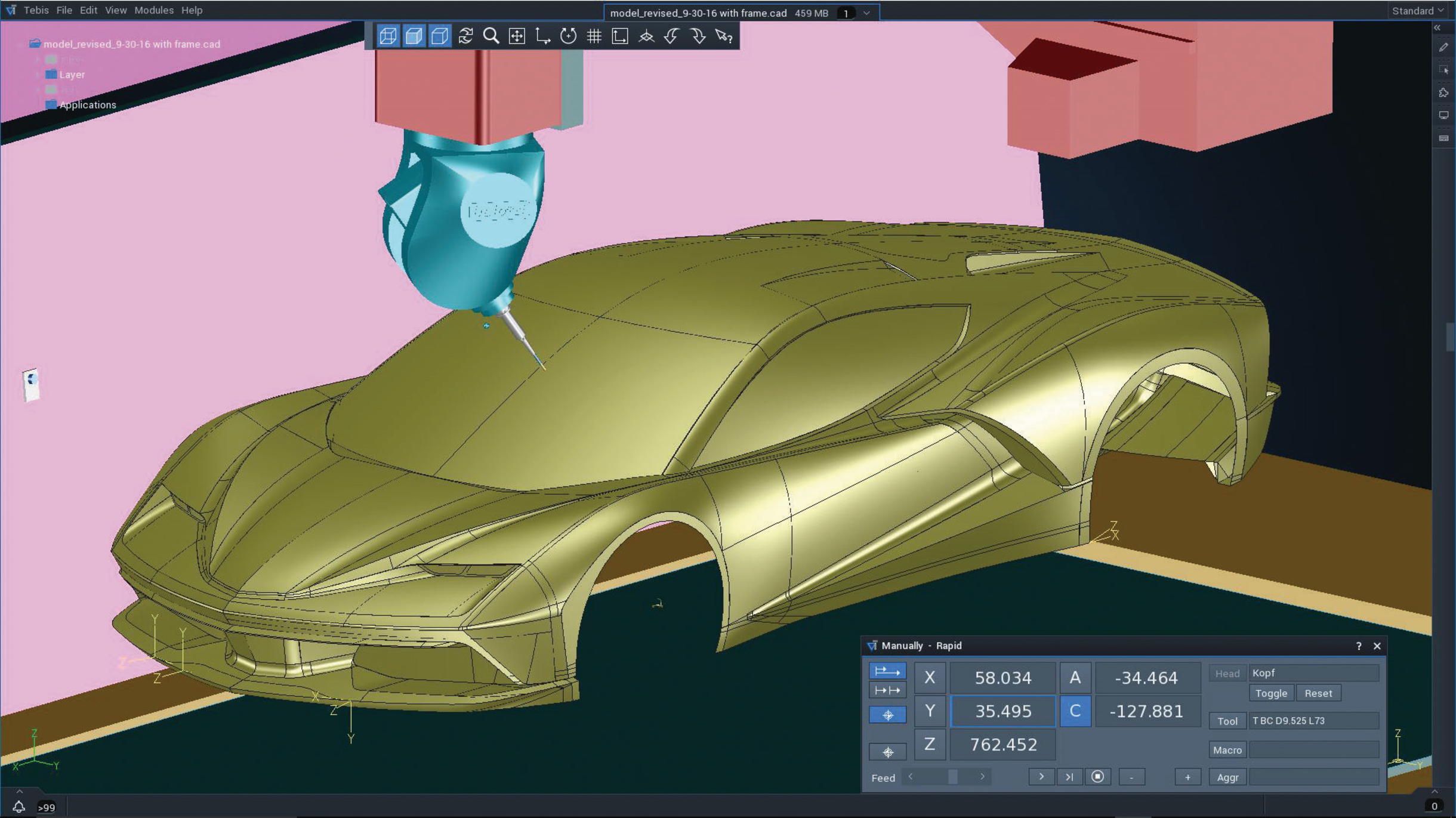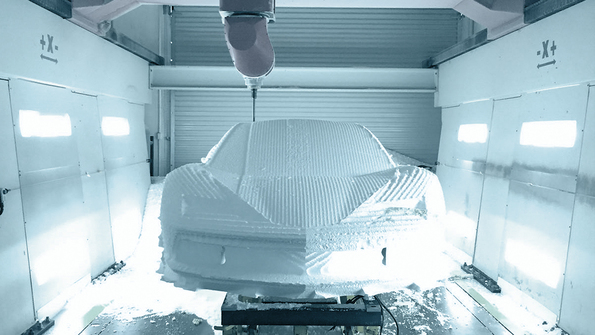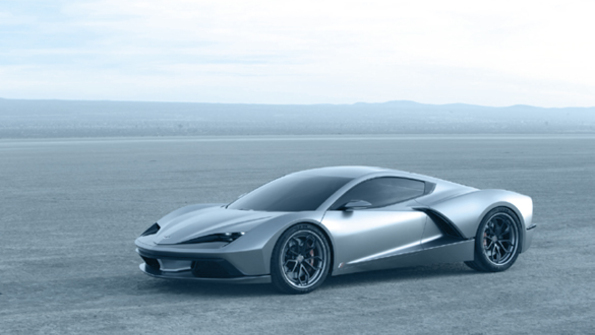-
Software
-
CAM software
- Tebis Automill
- CNC programming
- CNC automation
- CNC simulator
- Multiple setup
- Robotic machining
- CNC drilling
- Deep-hole drilling
- Combined turn-milling
- CNC turning
- Turn-milling
- 2.5D milling
- 3D milling
- 5-axis milling
- Slot milling
- Trimming
- HPC milling
- HFC milling
- Circle-segment cutters
- Sinker EDM
- Wire EDM
- 3D laser cutting
- Laser hardening
- Laser weld cladding
- CAD software
- CAQ software
- MES software
- Products
-
CAM software
- Services
- Consulting
- Sectors
- References
- Company
- News

-
 Home References
Home ReferencesWhat Software Would Fast Eddy Use?
The Aria Group and Tebis America have teamed up to speed and automate the production process
Visitors to a private event held in downtown LA coinciding with the LA Auto Show were impressed by a sleek, powerful looking concept car affectionately called "Fast Eddy." Just as impressive, though, is the company behind it. The Fast Eddy moniker derives from the late Ed Taylor, designer for General Motors, cult figure for many car buffs, and father of Charles Taylor, co-founder of the Aria Group, (Irvine, CA).
Company
Aria Group
Location
Irvine, California, United States
Focus
Machining of complex surfaces through Tebis' surface based approach.
Benefits:
- Surface based machining
- Tebis' time slashing abilities
- Integrated simulation advantage
Sector
Automotive
Model making
Published
2017

Interviewee: Clive Hawkins, Kevin Cain, President & CEO; Chief Technology Officer
It is an extremely capable, surface based machining software, not one that relies on mesh models. Our products have highly complex design surfaces so we needed a software that could support that. Tebis, with its surface based approach, can do that, and the quality of its surfacing is unparalleled.
Kevin Cain, Chief Technology Officer, Aria Group, Irvine, Kalifornien, USAThe Aria Group is a 21-year-old design and fabrication company that has built concept cars for major automakers and helps the Singer company restore its classic 911 automobiles. Charles Taylor and Aria's two other co-founders, Clive Hawkins and Kevin Cain, are fans of the late Ed Taylor's work so it's perhaps not surprising they decided to design and build the car they think Fast Eddy would drive today -- a mid-engine sports car inspired by classic American designs and loaded with both style and power.
The car's front end is reminiscent of the midengined Aerovette cars GM did, while the rear features a tapering greenhouse look and fender blisters. Other striking details include overhead outboard air intakes, headlamps and taillamps that are invisible until illuminated, and attractive HRE wheels.
Aria officials envision the car being built around a carbon-fiber monocoque and using carbon-fiber body panels. "We most definitely would use the LT4 Corvette engine," said Hawkins, citing its output of 650 horsepower and 650 lb-ft of torque in the Z06 as "world class" by any measure. The chassis is "ready to go," he said, and the whole thing would weigh under 3000 pounds.
At this point, the car is only a concept, with no engine and no interior, but Hawkins and design chief Nicholas David said that the car was received with such high praise that the Aria Group is now considering making a limited number of cars. "The car has been designed with the feasibility and engineering needed to build this car and achieve amazing performance and quality levels," Hawkins said. "Aria has the full capability to engineer and build this car."
 Tebis software played an integral part in the development of the concept car.
Tebis software played an integral part in the development of the concept car.The best of digital technology
A key part of that capability stems from Aria's partnership with CAD/CAM experts Tebis America, Inc., (Troy, MI). "Aria began working with us a couple of years ago," says Michael Thiessen, Tebis Sales Manager, West Coast. "They had been using MasterCAM, in conjunction with CATIA for design, but after extensive study they initially purchased one seat of Tebis. They quickly became convinced that Tebis should be their primary solution going forward, and now they have four seats."
"We started Aria to give our customers access to the best of digital technology, originally in terms of design but eventually in terms of manufacturing as well," says Kevin Cain, Aria's Chief Technology Officer. "That's where Tebis comes in."
"We strive to be a world class company, but we just didn't feel we were achieving the efficiency and quality we needed on the CAM and programming side," Cain continues. "After nearly a year of investigation we found that Tebis was the best programming solution out there. As a small company, we need to watch our resources, so deciding to make the switch to Tebis was a big decision for us."
It's a decision that paid off. "Tebis made our programming world class," says Cain. "It is an extremely capable, surface based machining software, not one that relies on mesh models. Our products have highly complex design surfaces so we needed a software that could support that. Tebis, with its surface based approach, can do that, and the quality of its surfacing is unparalleled."
Why the big difference between mesh and surface based approaches? "The surface created by mesh data is essentially like the pattern on the surface of a soccer ball -- a series of pentagons," says Thiessen. "As a result, you can’t generate highly accurate curves. In addition, mesh creates a surface that can be very ‘heavy.’" That is, the representation of the part’s surface is created using many smaller surfaces (as with those pentagons mentioned earlier). This added "weight" can be a problem when generating toolpaths. A Tebis surface, by comparison, is ‘light,’ which makes it easier to work with.
Better surfaces were just one of the factors that influenced Aria in its decision to go with Tebis. Another was automation. Specialized functions within Tebis enable programmers to automate and standardize various aspects of the NC programming process, allowing programmers to work faster in creating features and toolpaths without losing quality. Automation thus links directly with another major concern of Aria's: speed.
 5 axis machining of the concept car's body.
5 axis machining of the concept car's body.The need for speed
"We have a focus on speed," notes Cain, "speed of creating toolpaths plus speed of running the programs. It was clear that this was something that Tebis believes in." Along with its automation features, robust algorithms within Tebis speed preparation and programming, even for large components and complex geometries. In addition, simultaneous calculation processes help accelerate NC programming, and the software's "Multiple Setup" and "Tool Match" facilities can yield significant time savings on the shop floor.
Tebis' time slashing abilities made their presence felt on the recent high profile Fast Eddy project. All the Fast Eddy body parts were programmed with Tebis reports Aria programmer David Cardenas, who said they were created with the fastest turnaround time of any similar parts that Aria had done.
Aria is confident that the same sort of efficiency will characterize the next stage of the project if they move forward into full build, which Hawkins says will depend on the interest shown in the car. Pricing for Fast Eddy is predicted to be in the range of $600,000-$650,000, depending on the actual hardware specifications and the total number to be built. Hawkins reports that Aria could produce as many as 100 of the cars, although the soonest the first could appear would be 18 months to two years from now.
At the very least, the concept is a promotional tool for Aria as it engages automakers and other boutique builders and restoration groups like Singer. "It shows that we can design as a company, a reminder of our quality, and shows that we are in the position that we can do the design, the engineering, and build, even in limited production," says Hawkins. That's a significant benefit for a company whose work is 60 percent automotive.
This represents quite a journey for Aria which, as Kevin Cain notes, started out as a design consultancy. "Increasingly, though, customers wanted help in bringing their designs to life. As a result, we got into prototyping and then into limited production." Today the company has six 5-axis machining centers and other production equipment at its 60,000 sq. ft. facility in Irvine, along with 100 employees. In addition to automotive, the folks at the Irvine plant also do some aerospace work as well as work for the entertainment industry.
Significantly, the programming for those six 5-axis machining centers as well as other equipment at the plant is done in Traverse City, Michigan. That's where Chief Technology Officer Cain and his band of programmers are stationed. No wonder he says "Simulation was another important factor in our decision to go with Tebis."
 The full "Fast Eddy" concept car on display.
The full "Fast Eddy" concept car on display.The simulation advantage
"With the distance between Traverse City and California it's vital that we thoroughly and realistically check our programs before we release them -- even more vital than is typically the case." Cain says that among the things Aria focuses on are safety and accuracy, both of which are heightened by Tebis simulation. "We run their DMM3 premium package, with full 5-axis simulation capability."
Tebis simulation allows users to replicate complete machining sequences in the identical virtual machine environment, even across multiple NC machines. It lets users run virtual feasibility tests for their production department, and provides support for job cost planning -- especially vital for small to medium sized shops. It also increases process safety through visualization, collision avoidance, testing and optimization of production processes. "Safety, of the workpiece, the machine, and of course of the operator, are vital to us, and that's another area where our Tebis simulation with its collision avoidance capabilities really shines."
Tebis simulation and safety functions are designed to enable unattended machining/lights-out machining and reduce time and expense. Not only do they help prevent tool damage and expensive post-collision repairs to the machines, they also reduce setup and run times, and cut downtime and documentation time considerably. Thanks to Aria’s full integration into the Tebis CAD/CAM environment, the simulation and safety functions are a seamless link in the user's CAD/CAM/NC process chain.
The majority of Aria's use of Tebis has been on the manufacturing side. "We continue to do our CAD work in CATIA," says Cain, "but it’s all pretty seamless because Tebis has an excellent interface with CATIA. On the CAM side, Tebis is a single source solution, from programming the data, verification of the data, through posting of the data. Before we had to utilize one company for programming and another one for posting. Tebis, though, is truly a manufacturing solution that simplifies and automates their processes, and since adopting Tebis we've experienced big jumps in efficiency and in quality. Now we're 100% Tebis users."
Cain says Aria now has four Tebis seats. All of them are floating (i.e., they can be used in various locations). "Three are programming seats and one is a viewing seat that we can bring down to the shop floor for our operators. Our people have used it in the toolroom to help them decide which mill to post a job to."
Aria attended training, at Tebis and onsite at their Irvine facility. "The training was excellent," reports Cain, "and when we had training onsite we were able to customize it. Tebis has been a pretty short learning curve. Our guys became very proficient very quickly -- in a matter of a few months they went from not knowing Tebis at all to becoming very proficient programmers." Which underscores a crucial factor in manufacturing profitability: time. "And when it comes to time savings, Tebis has been a winner for us."

